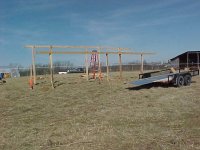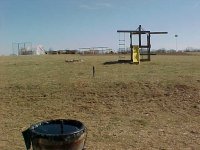wcampbell47
Platinum Member
- Joined
- Jul 21, 2009
- Messages
- 725
- Location
- Texas Coast
- Tractor
- Kubota L3901 ASV Compact Tracked Loader
We use "batter boards" (spelling?) to establish the approximate corners then pull string from batter board to batter board. Where the strings cross establish the corners of the building. Batter boards are simply 3 stakes driven into the ground with lengths of 1x4 nailed to them to form a 90 degree corner. Using this method you can use the 3-4-5 and diagonal method to make sure the building is square. That might be over kill for what you are doing, but a good square building makes for easier framing.
Think ahead several years as to what water and horse urine is going to do to that board you dig down into the ground to put in. Will it be easy to change out once it rots out. If not maybe you want to rethink that. A good 4 foot level is necessary on a project like this.
It would be good to notch your upright posts to receive any member that is going to bear the weight and snow load of the roof. That will transfer the load bearing to the upright post rather than to nails or bolts. Here in hurricane territory we notch the uprights and bolt the cross members to them.
Do you have access to a tractor with a front end loader? A FEL can be used to lift and set your upright posts.
Think ahead several years as to what water and horse urine is going to do to that board you dig down into the ground to put in. Will it be easy to change out once it rots out. If not maybe you want to rethink that. A good 4 foot level is necessary on a project like this.
It would be good to notch your upright posts to receive any member that is going to bear the weight and snow load of the roof. That will transfer the load bearing to the upright post rather than to nails or bolts. Here in hurricane territory we notch the uprights and bolt the cross members to them.
Do you have access to a tractor with a front end loader? A FEL can be used to lift and set your upright posts.

